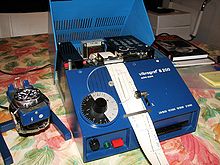Timing machine
A timing machine (also known as chronocomparator from French: chronocomparateur ; formerly also known as the “scales of times”) is an electronic device used to determine an irregularity in the movement of a clockwork . The beats of the clockwork are recorded with a structure-borne sound microphone or recognized based on the vibration and compared with a known frequency . Usually a quartz time base is used for referencing and the result is recorded in writing. The method thus offers a quick and easy way of determining gait errors and positional errors .
A faulty drop (limping gear) and the amplitude of the balance wheel can be analyzed with electronic timing machines.
Older devices write a short line on a continuous strip of paper for each stroke of the clock . The inclination of the lines formed then shows the rate error of the watch, the distance between the lines is an indication of the dropping error. Modern devices have an electronic display that shows all relevant data digitally. If a printout is nevertheless required, a printer must be connected.
Individual evidence
- ^ Helmut Kahlert , Richard Mühe , Gisbert L. Brunner : Wristwatches: 100 years of development history. Callwey, Munich 1983; 5th edition, ibid. 1996, ISBN 3-7667-1241-1 , p. 38 (on Reinhard Straumann ).
- ↑ Fritz von Osterhausen: Callweys lexicon. Callwey, Munich 1999, ISBN 3-7667-1353-1 , p. 365.
Web links
- Training documents on testing technology (PDF; 1.59 MB)
